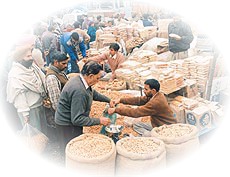| LOHRI |
|
| Celebrated :
13th January, Every Year. |
|
|
|
| Lohri is a festival connected with the solar
year. Generally, it is an accepted fact that this festival is to worship fire.
This is particularly a happy occasion for the couples who for the first time
celebrated Lohri after th eir marriage and also the first Lohri of the son born
in a family. Children visit homes in the neighbourhood and sing songs. One of
the famous ones is : |
 |
|
|
Sunder mundriya..ho
Tera kaun vichara..ho
Dulla Bhatti walla..ho
Dulle ne ti viahiyi..ho
Saer Shakar payi..ho
Kudi de boje payee..ho
Shallu kaun samete..ho
Chacha galee dese..ho
Chache choori kutee..ho
Zamindaran lutee..ho
Zamindara sidaye..ho
Gin-gin pole layee..ho
Ik pola reh gaya..ho
Sipahi farh ke lei gaya..ho
Aakho mundao taana..
Mukai da dana..
Aana lei ke jana.. |
|
| The day begins with
children collecting money from houses in the neighbourhood. In the evening,
winter savouries are served around a bonfire. Celebrated enthusiastically in
Haryana, Punjab and parts of Himachal Pradesh, it also signifies the beginning
of the end of winter. |
|
| Children go from door to door singing songs in
praise of Dulha Bhatti, a Punjabi version of Robin Hood who robbed the rich and
helped the poor. These "visitors" are given either money or gachak, bhuga, til,
moongphali, gur and rewri. |
|
| A bonfire is lit and
everyone gathers around it. Munchies, collected from each house, go around the
party and are also thrown into the fire. |
|
| The festival assumes
greater significance if there has been a happy event in the family during the
elapsed year, like the birth of a male child or marriage. |
|
| The family then plays host
to relations and friends wherein the eats take a back seat and merry-making
takes over. Move on folks! It is then time for bhangra, dhol, gidda and
light-hearted flirtation. Liquor flows freely and guests are served dinner. But
then liquor is a modern introduction and is not customary and celebrations
depend on how much does the pocket allow. |
|
| A popular belief in this
region is that if someone seeks a radish roasted in the bonfire lit by a family
that has reason to celebrate, then blessings are bestowed on the family of the
seeker as well. |
|
| Geographically speaking, the earth leans
towards the sun along the Tropic of Capricorn (Makara rekha) from the day
following Lohri, also known as Winter Solstice. The earth, farthest from the
sun at this point of time, starts its journey towards the sun along its
elliptical orbit, thus heralding in the onset of spring. It is this transition
which is celebrated as Lohri in northern India, Makara sankranti in the central
part of the country and as Pongal-Sankranti in South India. |
|
The festival is spread over
three days in South India and also signifies the beginning of harvesting. A
rath yatra is taken out from the Kandaswamy temple in Chennai on Pongal.
The day is celebrated as Ganga-Sagara in West Bengal and
according a belief, Hindus purify their sins by taking bath in the Ganges. A
big fair is also held on the Sagara Island, 64 km from the Diamond harbour
where the Ganga meets the Bay of Bengal. |
|
| Call it Lohri, Pongal or
Sankranti, the festival conveys the same message -- the bond of brotherhood and
the spirit of oneness should prevail despite all odds. |
|
|
|
|
|